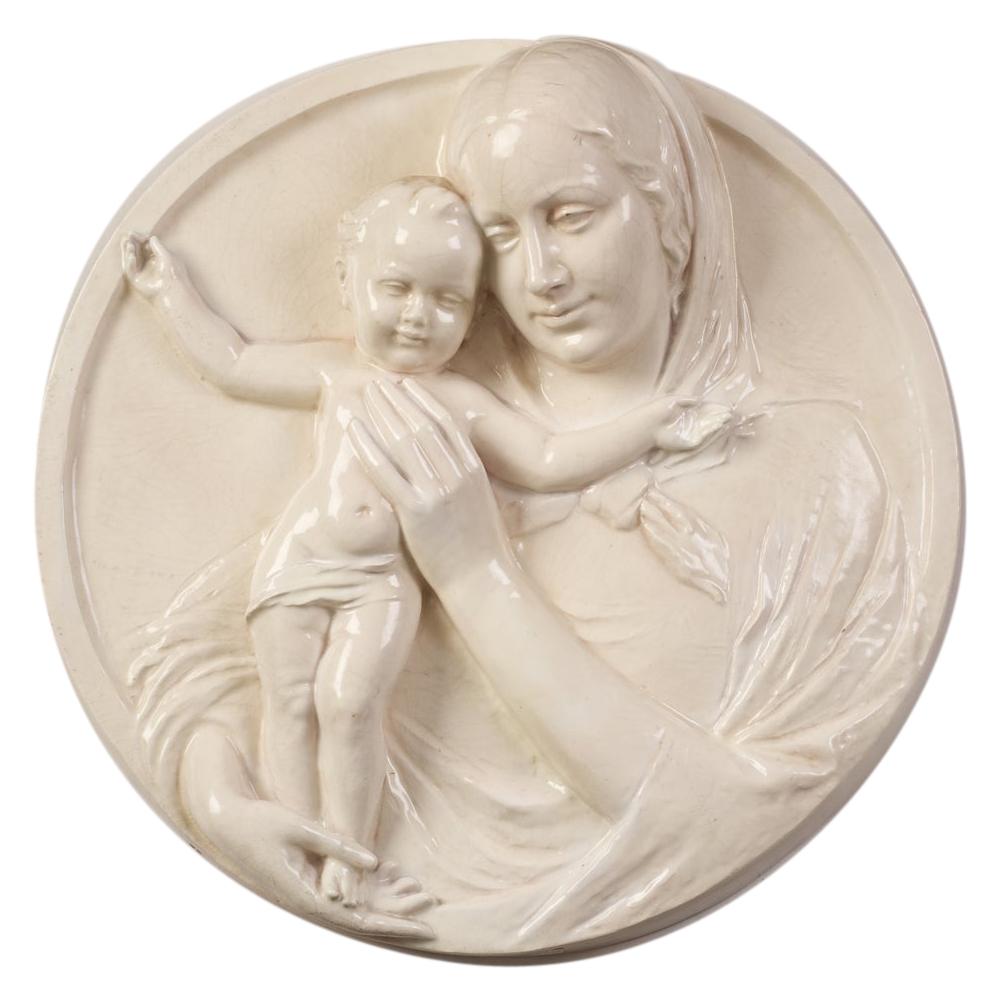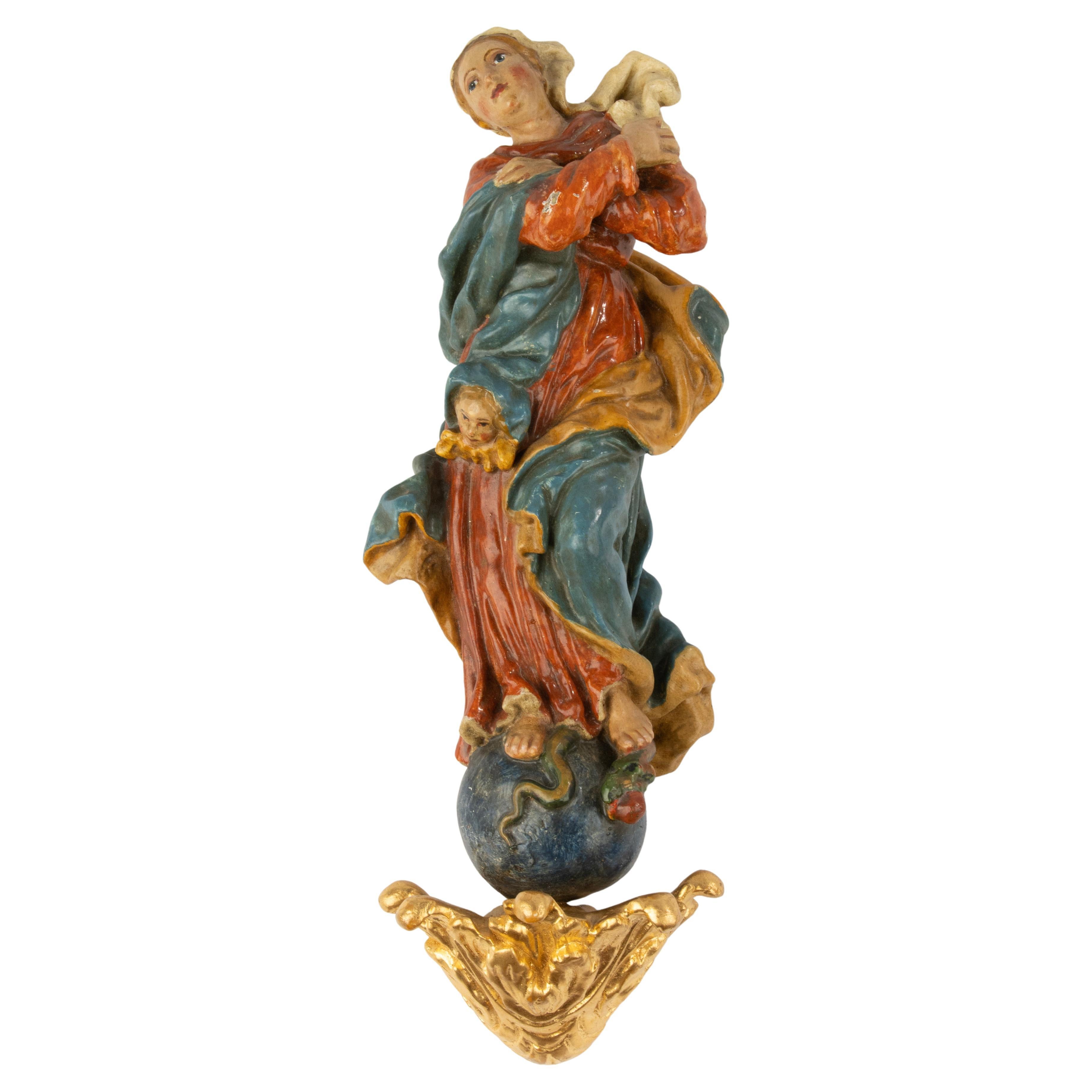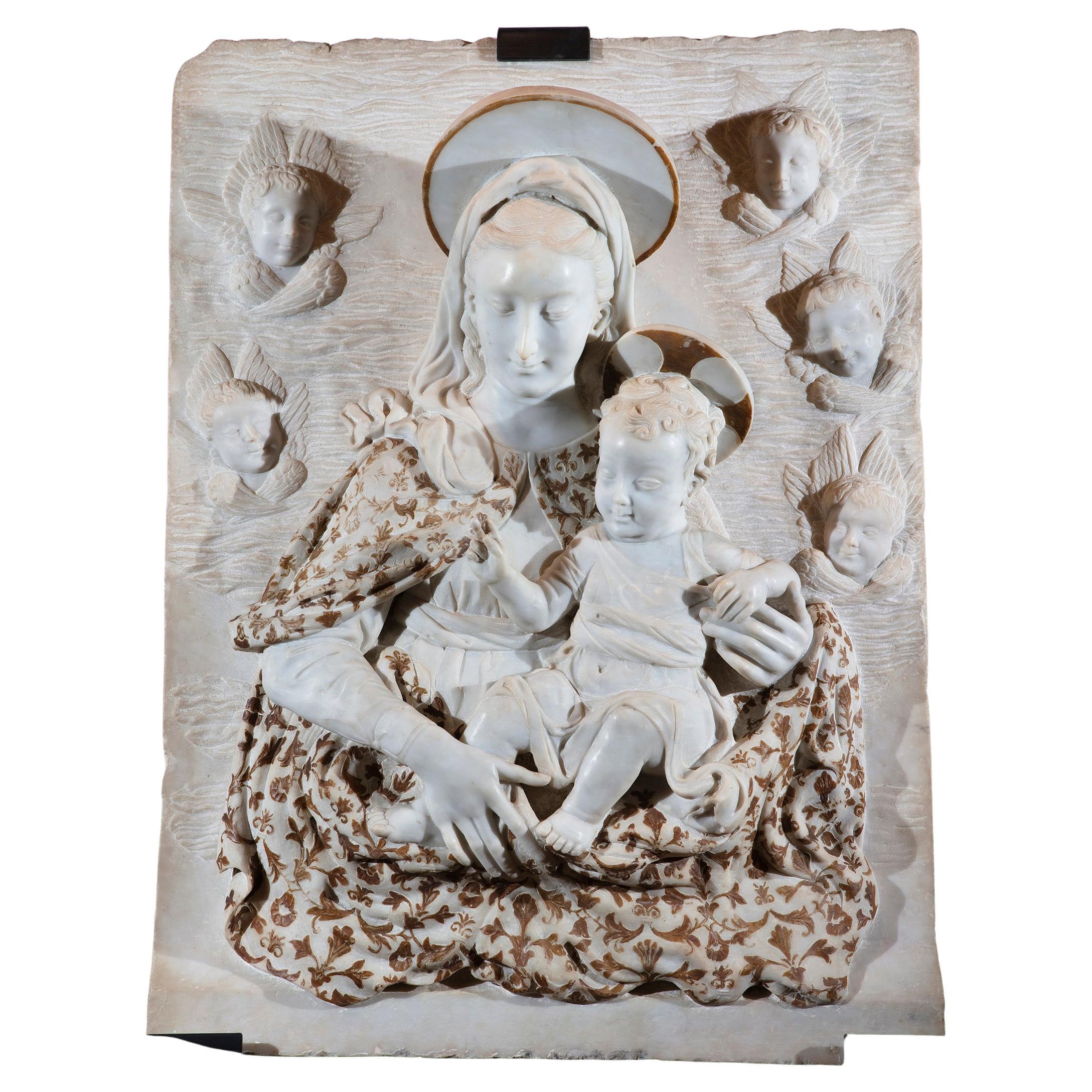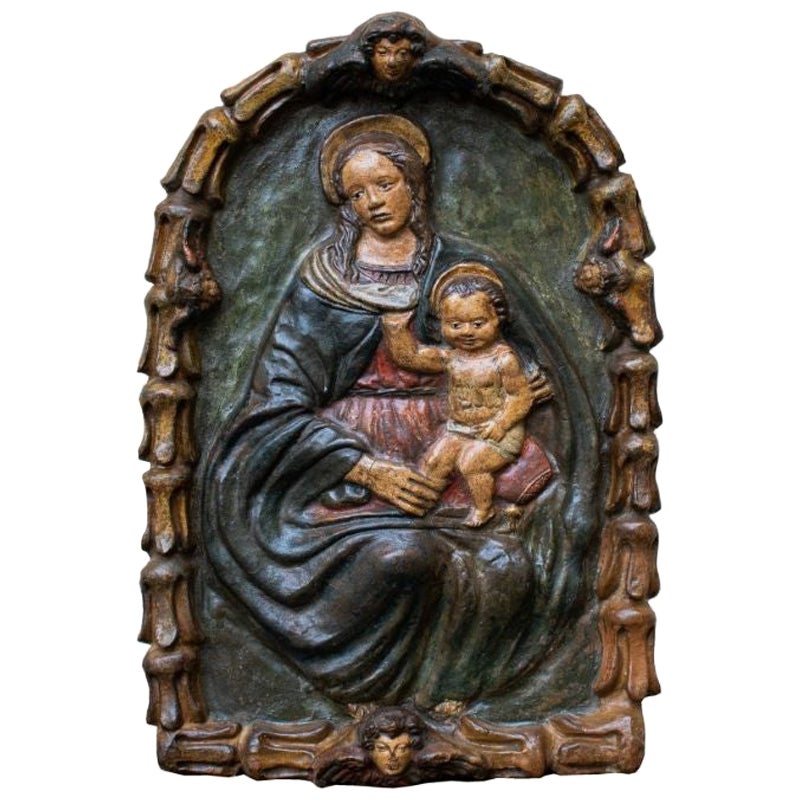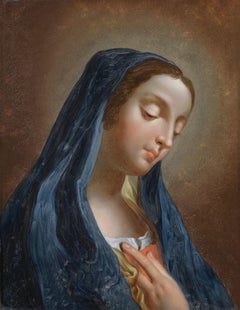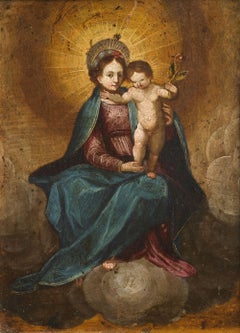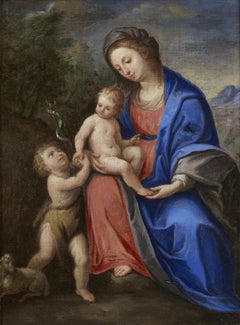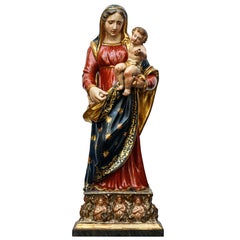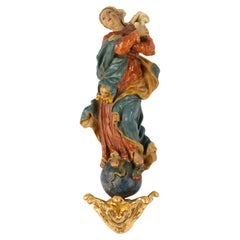Articoli simili a XIX Century Madonna Adoring the Infant Jesus Italian School Ceramic White Blue
Vuoi altre immagini o video?
Richiedi altre immagini o video al venditore
1 di 6
UnknownXIX Century Madonna Adoring the Infant Jesus Italian School Ceramic White Blue
15.000 €IVA inclusa
Informazioni sull’articolo
Cantagalli-manufactured ceramics measuring 125 x 67 cm depicting a sweet Madonna adoring the Child Jesus and the Holy Spirit.
At the beginning of the 19th century, Ulisse Cantagalli started an artistic production of ceramics, adding it to his kiln along the Via Senese in Florence that produced raw material for construction.
Ulisse, who was born in Florence on 18 June 1839 to Giuseppe and Flavia Franceschi, ran the company from 1872 and in 1878 hired an unemployed painter to become a skilled majolica decorator. By 1885, the company was already a highly regarded manufacture of artistic majolica, and the former painter, now director of works, employed around 30 painters and decorators (Corona) in addition to his two sons. Ulysses died on 29 March 1901 in Cairo, where he had travelled for health reasons.
At the Milan Industrial Exhibition of 1881, the Manifattura Figli [Ulisse and Romeo] di Giuseppe Cantagalli of Florence, which proved to be one of the leading manufacturers of ornamental majolica, was awarded a gold medal ‘for the merit of the many good style reproductions, as well as for the important attempt to solve the problem of producing objects with an artistic character at prices so low as to make them accessible to the generality of buyers’. Other honours followed at exhibitions in Antwerp, Paris and London.
The production approach, based on the imitation of ancient styles (Persian, Hispano-Moorish, Italian Renaissance and Della Robbia garments) and on the modest prices that facilitated sales and spread the taste for majolica, brought the company great success, the conquest of the Italian market, and the opportunity to make a name for itself in many parts of Europe, America and the Orient.
In order to achieve a good stylistic and qualitative level, Ulisse had personally studied 15th- and 16th-century specimens also by travelling abroad. He had also studied the ancient methods of preparing soils, coatings, colours and firing, and had patiently trained the workers: modellers and painters had been sent to study the works preserved in the museums of Arezzo, Pesaro, Loreto and other cities, as well as Florence. He had also maintained constant contact with foreign scholars, such as the English C.D.E. Fortnum and H. Wallis, and the Germans J. Lessing and W. von Bode.
The paintings and works of art published here are my exclusive property and therefore are always available to be viewed, by appointment, in my exhibition sites located in Sanremo and Brescia.
This item , like all our objects, is sold accompanied by a photographic certificate FIMA of authenticity and lawful origin; this document identifies the object by adding more value to the article.
We take care and personally organize the packaging and shipping of our items with insurance all over the world.
Mr. Riccardo Moneghini
Art Historian
- Dimensioni:Altezza: 125 cm (49,22 in)Larghezza: 67 cm (26,38 in)
- Tecnica:
- Movimento e stile:
- Periodo:1830-1839
- Condizioni:
- Località della galleria:Sanremo, IT
- Numero di riferimento:1stDibs: LU1510215521162
Informazioni sul venditore
5,0
Venditore professionale selezionato
Ogni venditore supera rigorosi standard di autenticità e affidabilità
Fondazione nel 2013
Venditore 1stDibs dal 2021
6 vendite su 1stDibs
- SpedizioneRecupero del preventivo…Spedizione da: Sanremo, Italia
- Politica di reso
Alcune parti di questa pagina sono state tradotte automaticamente. 1stDibs non può garantire che le traduzioni siano corrette. L’inglese è la lingua predefinita del sito.
Garanzia di autenticità
Nell’improbabile caso in cui si verifichi un problema con l’autenticità di un articolo, contattaci entro un anno per ottenere un rimborso completo. DettagliGaranzia di rimborso
Se il tuo articolo non corrisponde alla descrizione, è danneggiato durante il trasporto o non arriva, contattaci entro 7 giorni per un rimborso completo. DettagliAnnullamento entro 24 ore
Hai un periodo di tolleranza di 24 ore per annullare il tuo acquisto, senza necessità di fornire spiegazioni.Venditori professionali selezionati
I nostri venditori di livello internazionale devono aderire a rigorosi standard di servizio e qualità, garantendo l’integrità delle inserzioni.Garanzia miglior prezzo
Se scopri che un venditore ha pubblicato altrove lo stesso articolo a un prezzo più basso, applicheremo lo stesso prezzo.Consegna globale affidabile
La nostra rete di vettori leader del settore offre opzioni di spedizione specializzate in tutto il mondo, inclusa la consegna personalizzata.Altro da questo venditore
Mostra tuttoMadonna orante del XVIII secolo Giuseppe Bison Volto di Madonna Olio su vetro blu
Dipinto olio su vetro, raffigurante una Madonna orante di 55 x 45 senza cornice e 62 x 52 cm con cornice del pittore Giuseppe Bernardino Bison (Palmanova 1762 - Milano 1844).
Giusep...
Categoria
Fine XVIII secolo, Scuola italiana, Dipinti figurativi
Materiali
Vetro
18th Holy Family Italian School Virgin and Child Oil on Canvas Blue Purple White
Delicate and caring Madonna with child, oil on copper, measuring 23 x 16 cm without frame and 32 x 25 cm with frame.
Sweet colors and intimate attitudes for this painting that posse...
Categoria
Mid-18th Century, Scuola italiana, Dipinti figurativi
Materiali
Rame
1200 € Prezzo promozionale
20% in meno
Madonna con Bambino di scuola italiana del XVII secolo Olio su tela blu
Esaminando con interesse questa "Scena Sacra" della fine del 1500/inizio del XVII secolo (dipinto a olio su tela, 32 x 26 cm senza cornice e 40 x 33 cm con cornice) che rappresenta l...
Categoria
Anni 1610, Scuola italiana, Dipinti figurativi
Materiali
Tela, Olio
17th Century Allegory of Charity Carlo Cignani Madonna and Child Oil on Canvas
Di Carlo Cignani
Painting, oil on canvas, with dimensions of 105 x 120 cm without frame and 125 x 140 with a beautiful carved frame depicting the 'allegory of charity and love with a woman with three...
Categoria
1690s, Scuola italiana, Dipinti figurativi
Materiali
Tela, Oil
5625 € Prezzo promozionale
25% in meno
18° secolo Anna Gilli Natura morta fiori in giardino Olio su tela Greene & Greene
Di Anna Caterina Gilli
Esamina con interesse questa vivace "Natura morta" (dipinto a olio su tela ovale, 60 x 80 cm senza cornice e 78 x 88 cm con cornice), ambientata all'aperto in un parco con una piccola fontana in primo piano a sinistra e pini sullo sfondo. La dinamica inventiva è incentrata su vari gruppi floreali, di cui il principale è sparso a terra insieme a un piatto di maiolica ai piedi di una piccola base quadrata con altri fiori sopra, mentre a destra un vaso panciuto è su un pilastro di forma originale, da cui scende una voluta floreale che si ricongiunge in basso con altri fiori. La scena ha una trama cromatica brillante con una prevalenza di blu e una luminosità limpida che costituisce il suo elemento di coesione.
L'impronta stilistica e tipologica oltre che pittorica, insieme al suo gusto espositivo in linea con una piena adesione alla rocaille francese - si percepisce una diretta considerazione di Monnoyer e del suo diretto seguito - permettono di stabilire una collocazione di questa piacevole e raffinata "Natura morta" nell'area piemontese della prima metà del Settecento, e di conseguenza di identificarne l'autrice in Anna Caterina Gili (Torino, notizie dal 1729 al 1751). Uno specialista del settore che ha agito parallelamente al più noto Michele Rapous, ma che merita di essere messo in luce, vista la sua attività di sicuro rilievo, considerando le sue qualificate esecuzioni per la corte sabauda, che attestano una personalità più ramificata rispetto al collega, e dalla cui conferma possiamo infatti risalire alla sua mano per la raffinata "Natura morta" qui presa in considerazione.
Le sue opere conosciute che rimangono sono le tre "Decorazioni floreali" nell'Andito dell'Oratorio, nella Sala dell'Archivio Nuovo e nella Toilette della Regina al primo piano del Palazzo Reale di Torino, che furono presentate alla grandiosa Mostra del Barocco Piemontese...
Categoria
Metà XVIII secolo, Scuola italiana, Dipinti (natura morta)
Materiali
Tela, Olio
3375 € Prezzo promozionale
25% in meno
18th Century Earth Allegory Felice Cignani Putti Oil on Canvas Blue Green
Painting with a diameter of 130 cm and 160 x 160 cm with a marvellous frame depicting an ‘allegory of the Earth’ by the painter Felice Cignani ( Bologna 1660 - 1724 ).
An oil on ca...
Categoria
Early 18th Century, Scuola italiana, Dipinti figurativi
Materiali
Tela, Oil
Ti potrebbe interessare anche
Madonna col Bambino, Rilievo in Stucco policromo, bottega di Luca della Robbia.
Madonna col Bambino, rilievo in stucco policromo, bottega di Luca della Robbia. Seconda metà del XV secolo.
Modellato a mezzo busto, il Bambino tiene il velo della madre in una mano,...
Categoria
15th Century and Earlier, Medievale, Sculture figurative
Materiali
Altro
Madonna in ceramica con bambino ad alto rilievo
O/4832 - Bellissima Madonna in ceramica bianca ad alto rilievo con bambino, firmata Friska 1941 -
Dolce sorriso di madre e figlio!
Categoria
Metà XX secolo, Italiano, Estetismo, Sculture figurative
Materiali
Ceramica
Scultura in cartapesta del XIX secolo: Madonna e Bambino con anime del Purgatorio
Prima metà del XIX secolo
Madonna e Bambino con le anime del Purgatorio
Cartapesta laccata e dorata con base in legno policromo
cm 96,5 x 37,5 x 28
In quel momento chiesi al Signore Gesù: "Per chi devo ancora pregare?". Gesù mi rispose che la notte seguente mi avrebbe fatto sapere per chi dovevo pregare. Ho visto l'Angelo Custode, che mi ha ordinato di seguirlo. In un momento mi sono trovato in un luogo nebbioso, invaso dal fuoco e, in esso, da un'enorme folla di anime sofferenti. Queste anime pregano con grande fervore, ma senza efficacia per loro stesse: solo noi possiamo aiutarle. Le fiamme che li hanno bruciati non mi hanno toccato. Il mio Angelo custode non mi ha abbandonato per un momento. E ho chiesto a quelle anime quale fosse il loro più grande tormento. Ed essi mi risposero all'unanimità che il loro più grande tormento è l'ardente desiderio di Dio. Ho letto la Madonna che visitava le anime del Purgatorio. Le anime chiamano Maria "Stella del mare". Porta loro un rinfresco".
(Diario di Suor Faustina Kowalska p. 11)
Religiosa polacca, Santa Faustina Kowalska (1905-1938) reinterpretò nelle pagine della sua testimonianza l'antico ruolo della Vergine come salvatrice e sostenitrice delle anime del Purgatorio. Il Concilio Ecumenico Vaticano II stabilì che, assunta in cielo, la Madre di Dio dovesse operare una continua intercessione a favore di quei figli in attesa del Paradiso che si trovavano nel luogo, citato per la prima volta da Papa Gregorio Magno nei suoi Dialoghi, in cui attendere l'espiazione dei peccati terreni. Santa Brigida di Svezia, nata nel 1303, testimoniava come le anime purganti si sentissero sollevate nel sentire il nome di Maria mentre, poco più tardi, San Bernardino da Siena (1380-1444) ricordava come l'intento principale della Vergine fosse quello di mitigare il dolore delle anime in attesa della vita eterna. Molti teologi successivi hanno riaffermato la giusta importanza del ruolo della Vergine nel processo di salvezza entro i confini del Purgatorio, tra cui tutti Sant'Alfonso Maria de' Liguori (1696-1787); l'aiuto offerto dai fedeli, che possono recitare la preghiera del Rosario in suffragio dei defunti, è rimasto ugualmente utile secondo l'interpretazione successiva. In questa scultura le anime sono raffigurate all'interno delle fiamme canoniche della memoria agostiniana, adottando una pratica iconografica utilizzata sia per i dipinti che per le sculture di ogni epoca: ricordiamo a questo proposito le opere di analogo soggetto di Luca Giordano (Basilica di San Pietro di Castello, Venezia), Ludovico Carracci...
Categoria
Di antiquariato/d’epoca, Inizio XIX secolo, Italiano, Sculture figurative
Materiali
Carta
4252 €
Spedizione gratuita
Scultura policroma della Vergine Immacolata dell'inizio del XIX secolo - Germania
Questa scultura in legno finemente intagliata e dipinta in policromia raffigura la Vergine Immacolata in una posa classica, in piedi in cima al globo con un serpente sotto i piedi - ...
Categoria
Di antiquariato/d’epoca, Anni 1820, Tedesco, Barocco, Articoli religiosi
Materiali
Intonaco, Pino
1000 €
Spedizione gratuita
Scultore della fine del XIX secolo Madonna con il Bambino e teste di cherubini
Giovan Francesco Briglia (Roma 1737/39-1794),
"Interno di dispensa con selvaggina di penna e gatto", olio su tela, cm 74x100; cm con cornice 85,5x110
Corredato dalla scheda attribut...
Categoria
Di antiquariato/d’epoca, Late 19th Century, Italian, Sculture figurative
Materiali
Marmo
Madonna con Bambino in terracotta policroma dell'Impruneta Tondo del XVII secolo
Scuola toscana, XVII secolo
Madonna con Bambino - dall'Impruneta Tondo
Misure: Terracotta policroma, 65 x 46 x 10 cm
Questo rilievo in terracotta policroma, delicatamente s...
Categoria
Di antiquariato/d’epoca, XVII secolo, Italiano, Sculture astratte
Materiali
Terracotta
